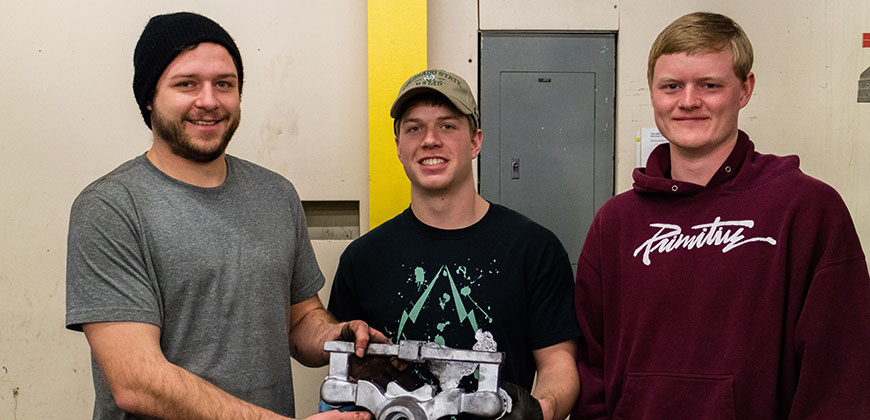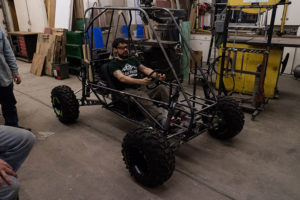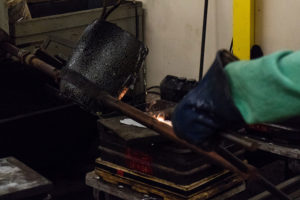
Engineering students David Konke, Zach Gumper and Trey Haltom work at the Motorsport Engineering Research Center to cast their racing vehicle’s unit bearings.
When it comes to car projects, the Walter Scott, Jr. College of Engineering has no shortage of offerings. There’s Ram Racing, Colorado State’s Formula Society of Automotive Engineers (FSAE) team, which has students design, build, and race a Formula-style car for an international competition. EcoCAR 3 is a U.S. Department of Energy Advanced Vehicle Technology Competition, and participating CSU students must work together to redesign a Chevrolet Camaro to reduce its environmental impact.
Recently students in the college also introduced Aggies Offroad Racing and Development, a student organization that facilitates the Baja Society of Automotive Engineers Senior Design group – a car project with a focus on off-road motor sports and recreation. It will be part of the E-Days Senior Design Showcase, April 14.

This isn’t the first time CSU has had a Baja SAE team, but the last time it competed in the international Collegiate Design Series was back in 1993. The club was re-introduced in November 2015, when Phil Gonzales and Alex Jones, now both senior mechanical engineering students, started a new Senior Design project.
“Phil and I asked our Senior Design instructor if we could add Baja SAE as a new project, and initially he said no. But we wrote up a proposal and presented it to him anyway, and he agreed to let us start the team,” said Jones.
Because Senior Design teams have a cap on the number of students who can participate, Gonzales and Jones both felt it was important to form Aggies Offroad Racing and Development as a student organization, to be inclusive of students who were unable to join the Baja SAE team, but still had an interest in motor sports. Members of the student organization are not required to participate in the Baja SAE vehicle build, but they can still learn design and manufacturing concepts through the various activities the group organizes, like welding, 3D printing workshops and engine rebuilds.
“We want Aggies Offroad to be a student organization where if you’re not in mechanical engineering or have no academic benefit of participating on the Baja SAE team, you still feel included as a member and that your time was well spent. We encourage participation from underclassmen if they’re interested in a particular task that’s going on at any given time. There’s always something to do, both with the club and with the vehicle – feel free to drop in and help out,” said Jones.
A synopsis of innovation
The workshops offered by Aggies Offroad Racing and Development expose club members to the foundational concepts needed to design and build an off-road vehicle, especially one that’s massively self-manufactured like this one. While some materials are purchased, most are crafted using on-campus resources, like the foundry located at the Motorsport Engineering Research Center (MERC). The tubing for the chassis, suspension, and power train are all cut, bent, coped, and welded in-house by Senior Design team members. To Jones, having the resources to build the car almost entirely in-house provides more freedom for innovation.

“One of the big things I’m extremely proud of is that this vehicle has a hydraulic regenerative energy system – when you brake, a hydraulic pump engages the transaxle and charges an accumulator. The driver has a dump button in the cockpit, and can use that to release the hydraulic pressure to a hydraulic motor that will drive the front wheels. Regardless of how well we perform in the competition, I know we’re going to turn some heads with this regeneration system and what we’re doing with it,” said Jones.
Few Baja SAE teams take this approach, and the CSU team is the first to use an energy regeneration system that is powered by the rear wheels and transfer it to the front wheels, giving the vehicle temporary four-wheel drive technology. The benefit of this function is that the vehicle is more capable of overcoming obstacles on the Baja SAE course, which consists of rough terrain and jumps.
The future of Aggies Offroad
As Jones’s time at CSU comes to a close in May when he graduates, he reflects on the growth and impact of Aggies Offroad Racing and Development, and considers what the group will become in the future. For him, it’s less about successors maintaining the current format of the student organization, and more about them taking advantage of the autonomy to adapt the club into what they want and make it their own.
“I want to provide a club that has an inclusive environment with enough potential for self-discovery and growth. I’m excited to provide a platform for what it can turn into, and part of that is being able to have trust in your members – it can only be as big as their mindset and vision,” he said.